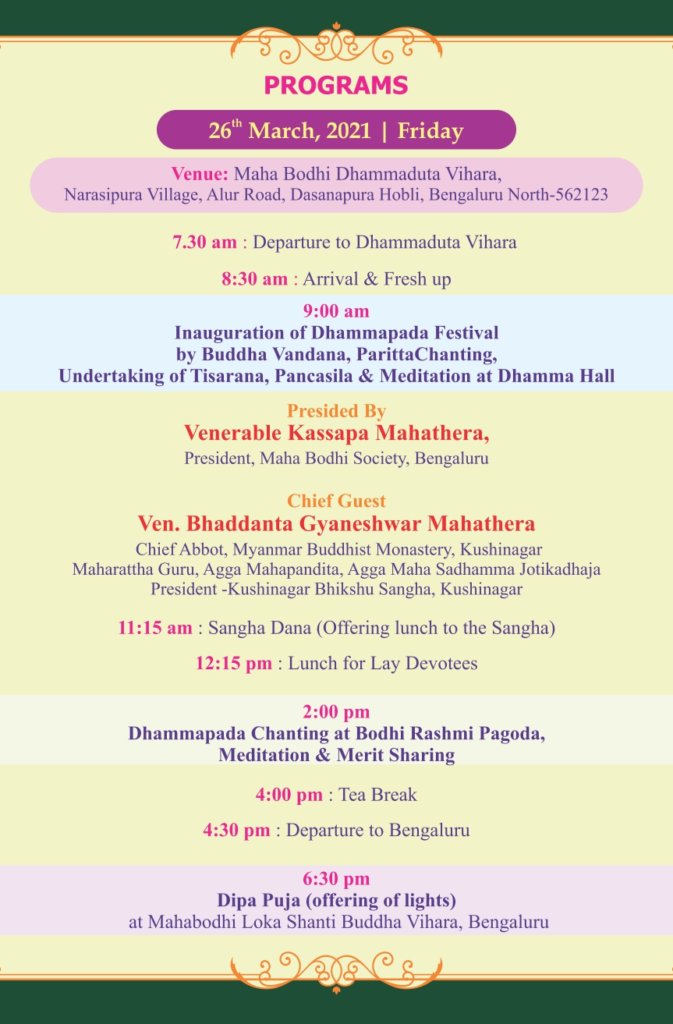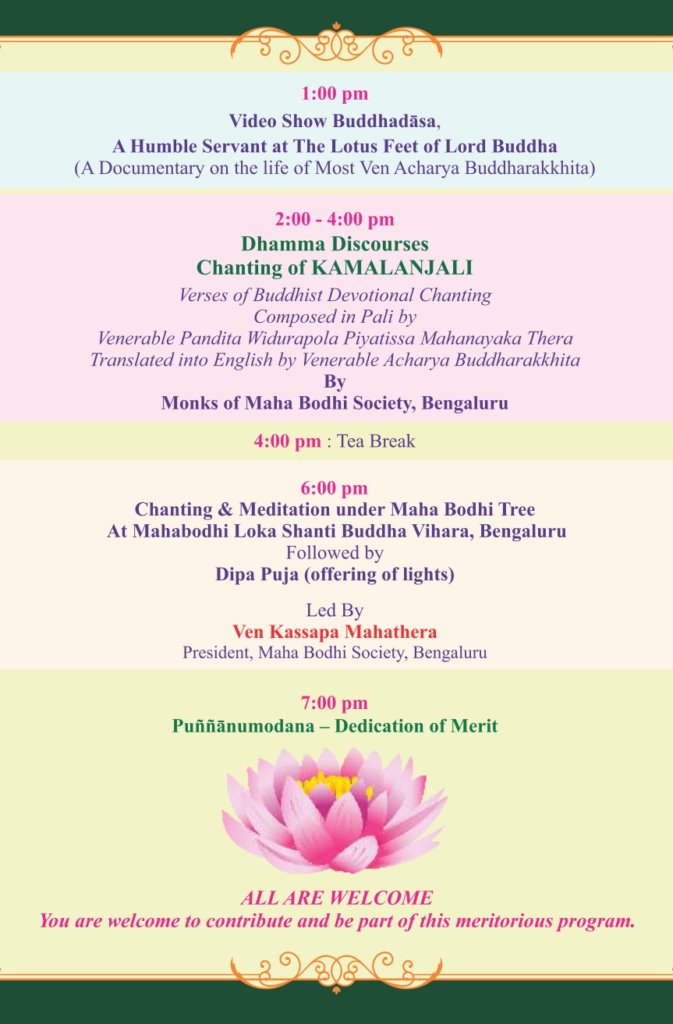Refuge in the Sangha
The Sangha of the Blessed One’s disciples is practicing the good way,practicing the straight way, practicing the true way, practicing theproper way; that is, the four pairs of persons, the eight types ofindividuals – this Sangha of the Blessed One’s disciples is worthy ofgifts, worthy of hospitality, worthy of offerings, worthy of reverentialsalutation, the unsurpassed field of merit for the world.33
Living, breathing role models are found in every religious tradition, but inBuddhism these become primary objects of veneration and trust. This makesperfect sense since living breathing persons have the most immediate influenceon our lives and are most likely to have brought us to Refuge in the TripleGem in the first place. Unfortunately sometimes we accord this privilegenaïvely to ruffians and scoundrels rather than to admirable friends. For theBuddha, the Noble Sangha is most worthy.
The phrase in the verse above, “the four pairs of persons, the eight types ofindividuals,” refers to the four stages of Awakening, beginning with StreamEntry, and subdividing each of these by “path” and “fruit.” These are theattainments that define the “Noble Sangha” or “Noble Ones.” Since thebenchmark goal of Buddhism is set at the singular attainment of Awakening,its role models have to be quite exceptional in their attainment of full or partial Awakening.
The subsequent lines refer to the practice of giving alms and veneration tomonks and nuns, the Monastic Sangha. The idea is that the Sangha brings greatbenefit to the world but that their attainment and presence are enabled by thosewho sustain them and thereby share in bringing benefit to the world, oftencompared to sowing a fertile field. The generosity of alms is thereby theprimary means of expressing veneration to the Third Gem. Both practices,veneration itself and generosity as specific expressions, are important elementsin cultivating wholesome mental factors for the actor, which is what meritreally is.
I’ve written a bit about the relationship of the Noble and Monastic Sanghas, thesoil and the roots, in the last chapter, and will examine this in even more detailin the next chapter. Suffice it to say here that there is quite typically anambiguity between the two. Recall that the former are individuals of greatattainment, the Noble Ones, and the latter the members of the monastic order,who individually may or may not be so noble. Generally when we extol thevirtues of the Sangha, as in the contemplation above we speak of the NobleOnes, yet the most common formula for first taking Refuge in the earlydiscourses usually in the Buddha’s presence, explicitly refers to the MonasticSangha. This gets confusing but the confusion seems to be deliberate, and isapt. If we think of the Monastic Sangha as a school that trains people tobecome Noble Ones we realize that offering alms to the Monastic Sangha is anecessary function for ensuring that there are Noble Ones in the world in anygreat number. Therefore it is support of the Monastic Sangha that ensures thatthe Noble Sangha will thrive. Analogously, it is support of higher educationthat ensures that scholarship will thrive.
Moreover, the monks and nuns play an important ritual role as objects ofveneration for it is they who are readily recognized as a Sangha through their(especially now, atrociously) distinctive attire. As such the Monastic Sanghanot only substantially includes the Noble Sangha, but nuns and monkscollectively or individually symbolize it, even if it is often in the way a pieceof plaster sitting on an altar might symbolize the Buddha. Monks and nuns areparticularly opportune ritual objects since they live and breathe, accept almsand actually eat them, and have a good shot at spiritual attainment, all unlikeBuddha statues.
In fact, the Vinaya requires that monks and nuns not offer teachings if theiraudience is disrespectful of them.34 It helps if the practice of giving alms is
thought of as the practice of giving not to a particular Noble One or aparticular nun or monk, but to the Sangha as a whole, undifferentiated, onbehalf of which a particular nun or monk receives the alms. Accordingly theBuddha said,
“..an offering made to the Sangha is incalculable, immeasurable. AndI say that in no way is a gift to a person individually ever morefruitful than an offering made to the Sangha.”35
Although the Buddha included himself in the Sangha it is remarkable that the“person individually” referred to was specifically himself in the context of thediscourse, the most Noble One of the Noble Ones. For the Buddha the Refugein the Sangha was huge.
Buddhism without Refuge?
The tyke born of a devout Buddhist family is likely to live his life centered inthe Sasana; he lives in the roots and leaves, not initially in the stem. The littleseedling will be brought into the presence of Buddha altars, and of monks,nuns and Noble Ones, and will have been taught the forms of veneration. Hewill have learned to recite the Refuges. He will have begun to absorb a fewDharmic aphorisms and will have learned to recite five Precepts. Withgrowing conviction, he will become increasingly involved in the communitylife, developing merit in taking care of the temple and the needs of themonastics, in chanting with gusto. He will someday become aware of the stemand may consider broadening his world to include the Path upward, perhaps toordain. A full encounter with samvega would likely bring him to that bolddecision quickly. Regardless, he will be inclined to support generously theaspirations of those who do make that choice, for he will understand thecivilizing force of the Noble Ones.
Living in a devout Buddhist community seems in itself capable of inducingremarkable results. I see this in many Asian Buddhists I’ve known. I also see itamong the devout of other religious traditions with similar forms of religiousexpression, which one way or another seem to produce some people of someattainment, even without a Noble Eightfold Path or anything resembling it. Ithas a remarkable capacity for generating confidence, zest and many
wholesome mental factors in its adherents, and can produce centered, selfless,composed, kind and insightful people. One can thrive in the grass on the basisof the practice of veneration alone.
A totally different profile would be someone who has not grown up with afoundation in the Buddha-Sasana, a common profile in the West. He might bereluctant to commit to the Refuges or Precepts, has not lived in a Buddhistcommunity, knows nothing about Noble Ones, does not know what functionnuns and monks could possibly serve or why they don’t go out to get jobs. Hemight have begun by reading about Buddhism, inspired perhaps by a vaguesense that Buddhism is a good thing, maybe having seen the Dalai Lama onTV or inspired by Buddhism’s reputation as “peaceful,” or by readingSiddhartha by Hermann Hesse.
In any case he has been moved to take up Buddhist practice, particularlymeditation, much as he had been moved to take up working out in a gym theyear before. Just as the gym membership had made his body stronger, he hopesthat joining a “sangha” will make his mind stronger. He likes the idea ofAwakening and might even expect to awaken if he meditates ardently for acouple of years, but has no perspective beyond improving this one short life.
This chap lives in the world of the stem. Without deep veneration norinvolvement in a Buddhist community he is nourished only by theexperience of practice itself. He has no sense of where this nourishment comes from nor responsibility for preserving it for future generations. He isunaware of the Sasana, the living flower. Accordingly he gazes down upon thegrass with disdain, little comprehending the roots and soil and the spiritualgrowth that is happening down there. I know this profile well: It used to bemine. His practice is likely to be precarious for a time, but he might eventuallygain some strength if he manages to grow deep roots. He is spiritual but notreligious. The astute reader will notice the absence of the blossom ofAwakening in this illustration. Full Awakening is individually such a rareaccomplishment under the best conditions, it is hardly conceivable that it isever attained without the nourishment provided by the Triple Gem.
Khandro Rinpoche: Refuge in the Sangha









![]()


